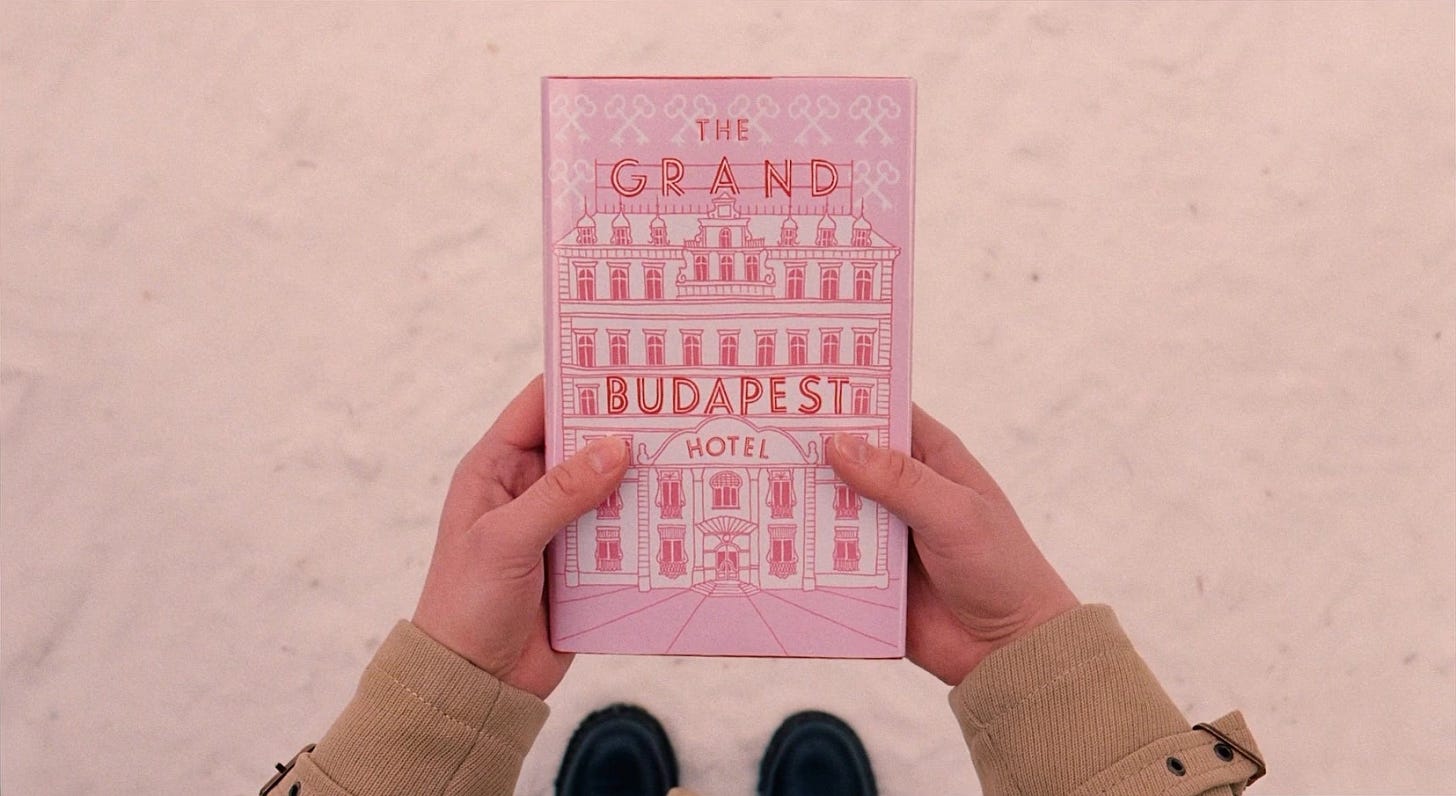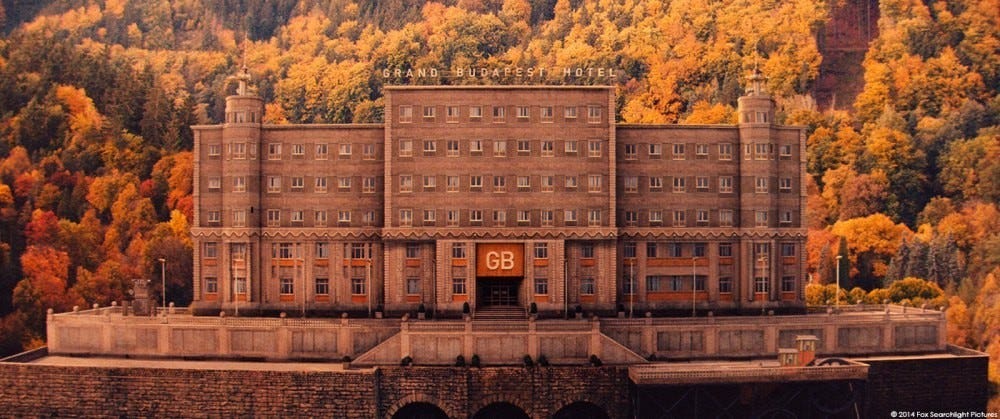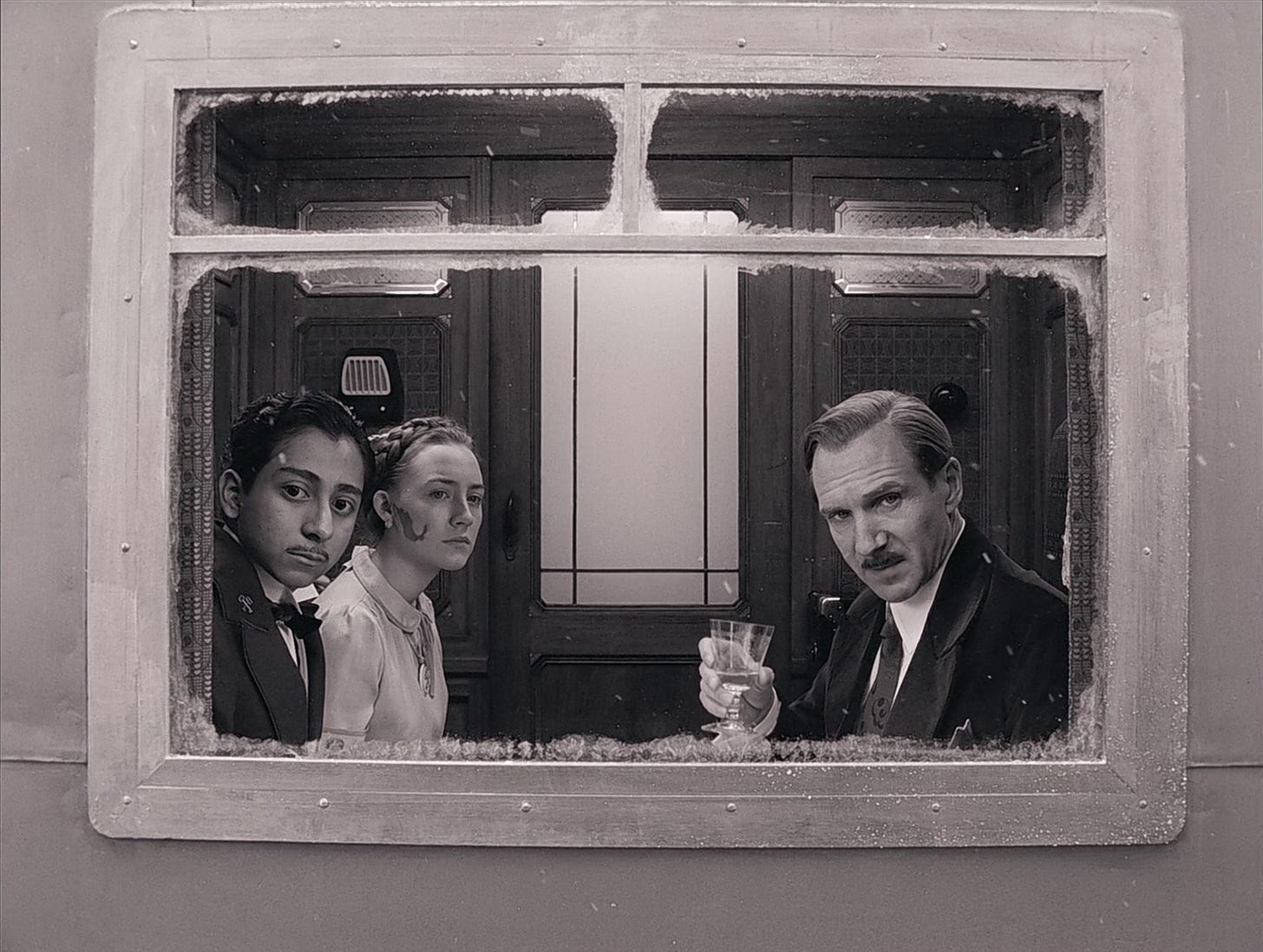The Grand Budapest Hotel (Wes Anderson, 2014)
The Grand Budapest Hotel (Wes Anderson, 2014) is a visually spectacular comedy-drama film featuring a seventeen-actor ensemble cast in the fictional Eastern European country of Zubrowka. The movie revolves around the setting of the Grand Budapest Hotel, a twentieth century mountainside resort that was once gloriously lavish but has since become unfashionable and fallen into disrepair. It explores themes of friendship, loyalty, fascism, nostalgia and upper class living.
The Grand Budapest Hotel is an Anderson classic, epitomising his aesthetic. American filmmaker and modern-day auteur Wesley Wales Anderson is recognised for his unique, eccentric movies with creative visuals, considered use of colour, experimental narrative styles and frequent use of ensemble casts. The Grand Budapest Hotel ticks all these boxes. He is also known for working with a particular set of actors, fifteen of which participated here, including Willem Dafoe (Jopling), Jeff Goldblum (Kovacs), Harvey Keitel (Ludwig), Bill Murray (M. Ivan) and Edward Norton (Henckels).
The story follows the hotel’s poised, practised, eccentric concierge, M. Gustave, and his loyal lobby boy/closest friend, Zero, after their lives get tangled up in a complicated conspiracy surrounding the will of Madame D. After she leaves him the vastly valuable painting ‘Boy With Apple’, her son Dmitri is so enraged and desperate for the asset he accuses Gustave of Madame D.’s murder. The military police arrest the concierge, forcing him to flee prison and try to prove his innocence with the help of Zero and Zero’s humble baker girlfriend Agatha. By the time they return to the hotel, it has been transformed into a base for the fascists occupying Zubrowka. Dmitri follows them but the trio are saved by the discovery of Madame D’s second will, which leaves everything to Gustave, including the Grand Budapest. Zero and Agatha marry but she and their baby pass away two years later. Gustave is also shot dead by fascist soldiers whilst concealing Zero’s illegal immigration. The hotel is left to Zero, which he keeps decades later in honour of Agatha, with ‘Boy With Apple’ still hanging.
The Grand Budapest Hotel is fragmented into three separate time periods, distinguished through varying aspect ratios and colour.
It opens in the most recent era shown in the film, presumably the 1990s, where a dedicated fan visits the grave of the author of the novel ‘The Grand Budapest Hotel’. This portion is presented in standard 1.85:1 ratio, making it appear more modern. The colours are sad, grey and muted, showing us a world far from the times of the Grand Budapest Hotel, yet its life and wonder remains immortalised in book form, represented through the bright and pink cover.
In the book, the unnamed author recounts a story he discovered whilst staying in the shabby Grand Budapest Hotel in 1968. We witness an old Zero telling the story to the author. Now the scenes are captured in widescreen 2.40:1 ratio, which was popular around the 60s and 70s. This era is distinguished through a warmer golden feel with rich yellows, golds and greens.
The time period introduced third is the predominant one: the real tale Zero experienced, that he confided to the author, and that the author ultimately wrote about in his novel. This takes place in the 1930s, when Zero was just a lobby boy, and he still had his mentor and love of his life at his side. The aspect ratio appears very old-fashioned, using the 1.37:1 format, or Academy ratio, which was massively popular in the 30s. Colours are less saturated, with light pinks and deep reds. Overall this is the era that appears the most beautiful aesthetically, as Zero is telling the tale, and he looks back on it with great fondness and nostalgia.
Nostalgia is one of the themes in the movie that left a significant impression on me. With each more recent era, the colour fades away; as we cast our mind further back, everything appears brighter and lovelier. Zero remembers his past with Gustave and Agatha with such warmth that the memories of fascist occupation, fear about his illegal immigration status, and the stresses of running from the law don’t taint or drain any of the colours away. Furthermore, this means that, when we see Gustave’s death in black and white, we fully understand how deeply and tragically it affected him.
I also admire The Grand Budapest Hotel for its representation. Immigrants are a significant group represented through Zero’s character. An illegal refugee, he was fleeing a war and the fascist regime that killed his family. His dedication to his work is viewed as admirable and he is presented as having great skill, in comparison to the white lobby boy who is shown to be clueless. This completely challenges the common racist argument against immigration that they ‘steal our jobs’. Zero is completely capable and exactly where he belongs. Furthermore, Gustave welcomes him entirely into his world and grows to view him as a complete equal, and regularly defends him when his citizenship is questioned, even dies for it. All kind, good characters in the film view him as a human being. Only the fascists view him as a threatening foreigner. It is clear who we are going to align ourselves with.
Homosexuality is a less noticeable piece of representation, hinting around Gustave throughout the film. When Dmitri learns the concierge has been left ‘Boy With Apple’, he attacks him with homophobic slurs and labels him a ‘fruit’ and a bisexual. Gustave has no adverse reaction, but remains calm and unbothered in a way that implies being called a ‘fruit’ is no insult at all. Additionally, Gustave does display several stereotypes of a gay man, being flamboyant and well-groomed; however, it is balanced by his status of a bachelor and his fondness of the company of older women. In this way, he never simply behaves as ‘a gay man’ for comedic effect.
my favourite gag:
The only reason it doesn’t deserve five stars is that personally, on first watch, sometimes the narrative was hard to follow. Otherwise: incredible film. Gorgeous, hilarious, brilliant.
★★★★1/2








